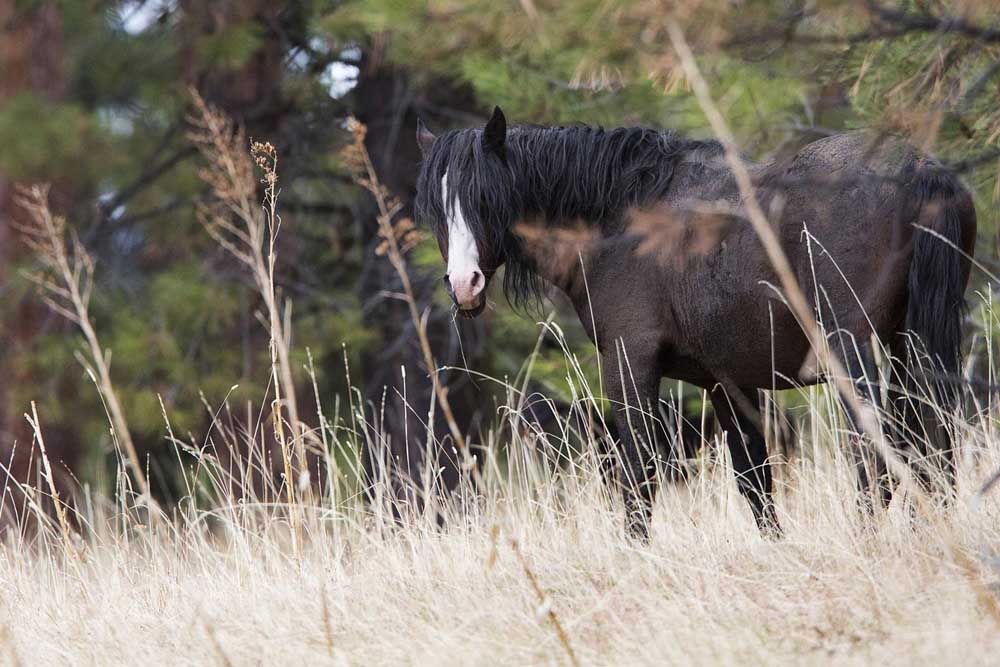Wild horse adoption facility planned for Central Oregon
Published 4:47 pm Friday, November 18, 2022

- A wild horse is seen in 2018 within the Big Summit Wild Horse Territory, a 27,300-acre range near the western edge of the Ochoco National Forest.
The U.S. Forest Service has unveiled plans for a wild horse adoption center to temporarily hold horses removed from the Ochoco National Forest.
The $3 million facility will include pens, pastures, security fencing, an access road and RV hookups for custodians, according to details available on the U.S. Forest Service website. The purpose of the facility is to safely hold and care for the horses while they wait to be adopted by members of the public.
The proposed facility is planned for the Rimrock Springs Wildlife Area, adjacent to the Crooked River National Grassland administrative site. A small dam blocks a stream in this area, creating a wetland for waterfowl.
The removal of dozens of horses from the Ochoco National Forest is being planned by federal officials because they allege grazing by the horses is damaging sensitive riparian habitat. Slimming down the Big Summit herd will limit the impact the horses have on the environment, the Forest Service says.
The Big Summit herd grazes on 27,000 acres located between 4,000 to 7,000 feet in elevation.
The horses are believed to be descended from ranch horses that were let loose by their owners a century ago, the Forest Service said.
“Most sources agree that horses once roamed beyond the limits of the present territory, and were said to be good quality animals as ranchers would selectively turn breeding stock loose to ensure a supply of horses would be available when needed for ranch work,” said Kassidy Kern, a spokesperson for the Ochoco National Forest.
The herd currently has 130 to 150 animals. The Forest Service management plan said the number should decline to a range of 47 to 57 horses. The holding facility is expected to have a maximum capacity of 35 animals.
Development of the adoption facility will be documented using a categorical exclusion, which is a category of environmental review for projects that don’t normally have significant effects on the environment and have no extraordinary circumstances that could cause significant impacts. An environmental assessment is not needed when categorical exclusion is used.
There is no timeline to start construction because the planning process for the facility is incomplete, said Kern.
“We anticipate that the planning phase will be complete by sometime in the spring,” said Kern. “Once this is finished, then we can move on towards implementation and the construction phase.”
In addition to the $3 million price tag for the facility, operational costs are expected to include $7 per day, per horse for feed, and $812 per horse for veterinary care and adoption services. These costs do not include Forest Service personnel salaries for capture and care.
A similar facility, operated by the Bureau of Land Management, is located near Burns. A request by the Forest Service to use the Bureau of Land Management facility for holding Ochoco horses was declined last year due to limited holding space.
Actual gathering of horses has been postponed, said Kern. The agency had planned on starting gathering this month, but a shortage of staff has caused delays, she said. A year ago it was supply chain disruptions that prevented the horse gathering from starting.
When gathering does begin, one implementation scenario has approximately 32 horses removed from the territory annually for the first five years, followed by intermittent gathering every two years. The Forest Service anticipates that the holding time from capture to adoption will be four to five weeks.
Capture and care of the horses is expected to occur during the fall and winter months.
The chosen site, the former headquarters of the Crooked River National Grassland, already has some usable infrastructure in place, including options for providing power and water. The Forest Service and the Oregon Department of Fish and Wildlife will jointly operate the Wildlife Management Area.
The location was selected in part because of the existing infrastructure, but also because it is accessible year-round, unlike other areas of the Ochoco National Forest, which can be blocked in winter by snow.
But even as the Forest Service moves ahead with its plans for the facility, a lawsuit filed by Prineville-based Central Oregon Wild Horse Coalition is in the courts to potentially stop the removal of the horses.
Gayle Hunt, a plaintiff in the case, said it’s premature for the Forest Service to begin work on the horse adoption center with the litigation pending. “They may lose this lawsuit and have no horses to put up for adoption,” she said.
Hunt, a former Forest Service employee, said the lawsuit is currently in a “holding pattern,” with oral arguments expected to begin in January.
The Wild Horse Coalition is against the removal of horses because it says a small herd of just 50 or so animals could be quickly wiped out in strong winter weather and is susceptible to predation by wolves and cougars.
Hunt and her group have previously advocated for the development of a horse adoption facility and wanted to partner with the Forest Service to offer its expertise.
She says the coalition was not offered a chance to participate in the design of the facility and she is concerned about the health of the nearby wetlands.
“Our vision was predicated on the agency having some expertise, partnership with and assistance from us, and some consideration for the sensitive wetland environment at that location, none of which are part of this ever-expanding plan,” said Hunt.





